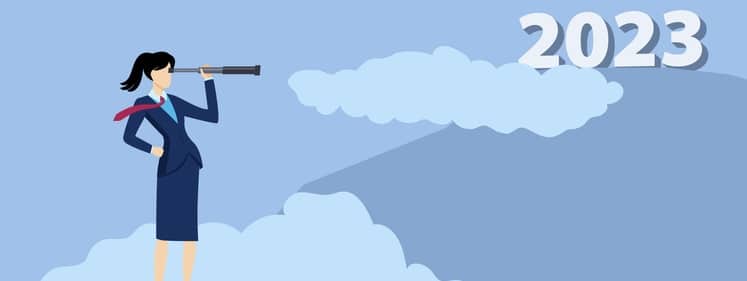It’s a bit surreal to think that here in 2023, women are still having to battle many of the same challenges in the business world that they’ve been fighting for many decades. But equal pay, upward mobility, and comparative respect from colleagues are among the obstacles that permeate the business culture across industries. Certainly, significant progress has been made, but at what seems like a snail’s pace. Where do things stand in 2023?
Now in its ninth year, the latest Women in the Workplace report from LeanIn.Org and McKinsey & Company, the largest study on the state of women in corporate America, breaks down four myths about women’s experiences at work by providing data-driven insights into the challenges they face at each step on the corporate ladder. The insights are based on data from more than 270 companies and more than 27,000 employees.
This year’s report affirms that, despite hard-fought gains at the top, women’s representation is not progressing fast enough
Women’s representation in the C-suite has grown to 28 percent, the highest it’s ever been, and there’s been strong progress at VP and SVP levels. These are notable but fragile gains without sustained improvements throughout the pipeline.
The “Great Breakup” the researchers discovered last year—where women leaders left companies at the highest rates we’d ever seen and at higher rates than men leaders—continued for women at the director level, the group next in line for senior leadership positions. And women of color remain underrepresented at every stage of the pipeline, and make up a mere 6 percent of the C-suite.
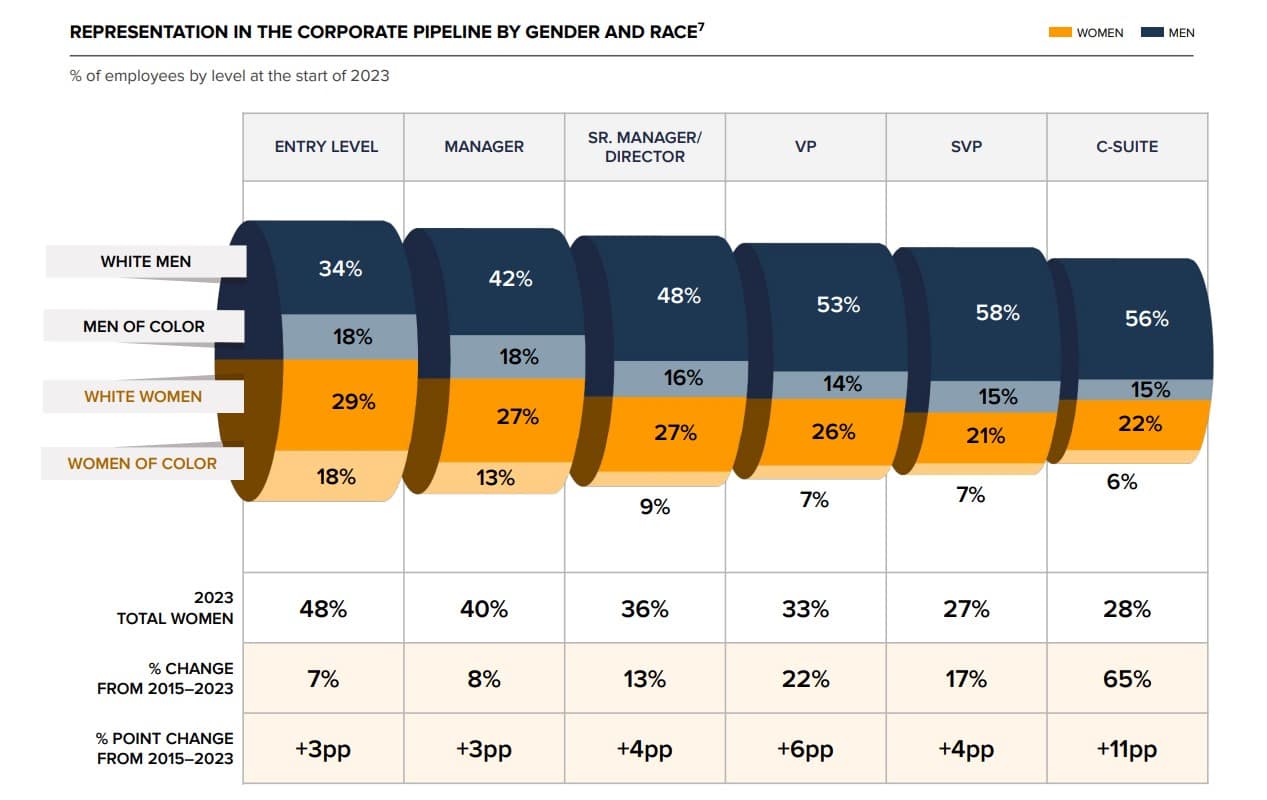
Myth #1: Women’s ambition is declining—and flexible work is mostly to blame.
Reality: Women are more ambitious than before the pandemic—and workplace flexibility is powering that ambition.
At nearly every stage of the pipeline, women remain highly ambitious and just as ambitious as men. This includes women who work hybrid or remotely—no drop in ambition:
- Ninety-six percent of women say their career is important to them and 81 percent are interested in being promoted to the next level—same as men.
- Women directors aspire to senior leadership just as much as men at the same level.
- Nine in 10 women under the age of 30 want to be promoted to the next level, and three in four aspire to become senior leaders.
- Women of color continue to be highly ambitious, as we’ve seen in past years: 97 percent say that their career is important to them, and 88 percent want to be promoted to the next level.
Flexibility unlocks ambitious women’s career aspirations:
- Women who work hybrid or remotely are equally committed to their careers and equally as ambitious as women and men who work on-site.
- Women say reduced fatigue and burnout is one of the biggest benefits of remote and hybrid work.
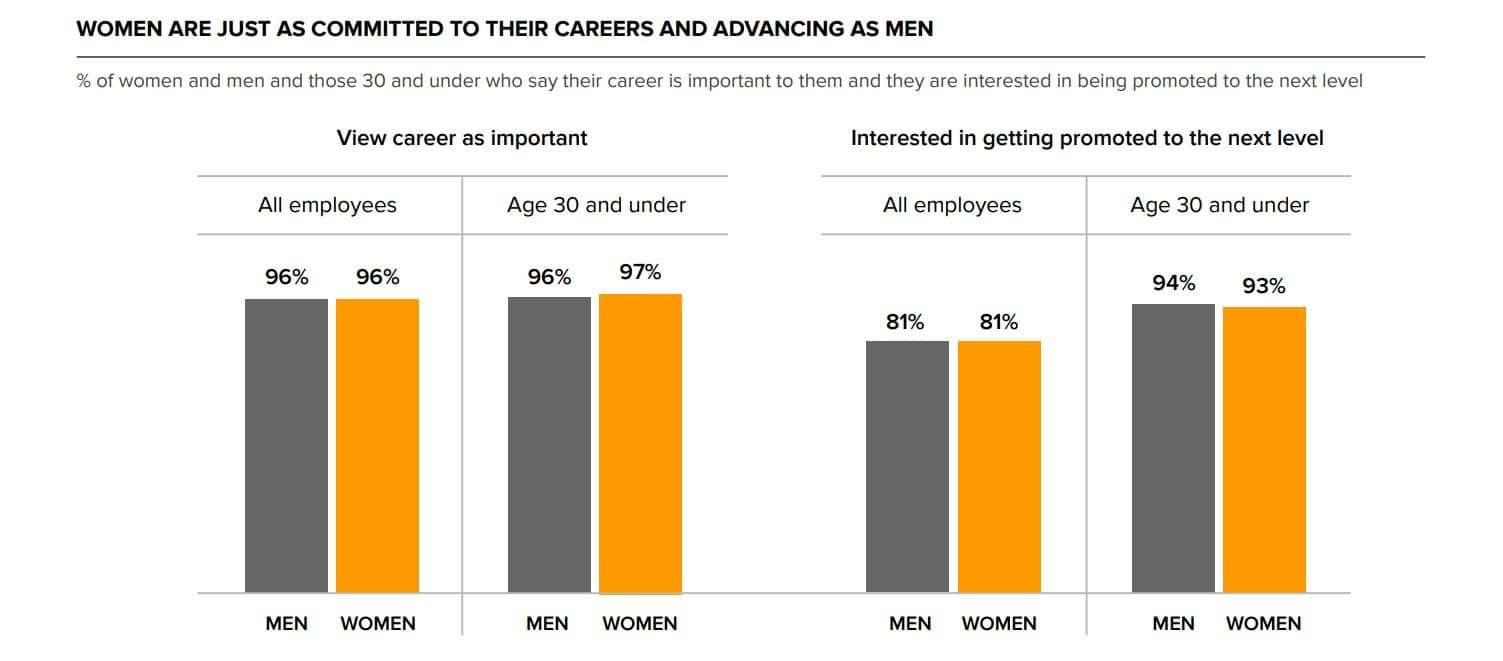
Myth #2: The biggest barrier to women’s advancement is the “glass ceiling.”
Reality: The “broken rung” continues to be the greatest barrier women face on the path to senior leadership.
This year, for every 100 men promoted from the entry level to manager, 87 women—and only 73 women of color—are promoted:
- The broken rung holds back Black women and Latinas the most. For every 100 men promoted from entry level to manager, only 54 Black women and 76 Latinas are promoted.
- Not surprisingly, more women getting stuck at the entry level has a long-term impact on the talent pipeline—it means women can never catch up.
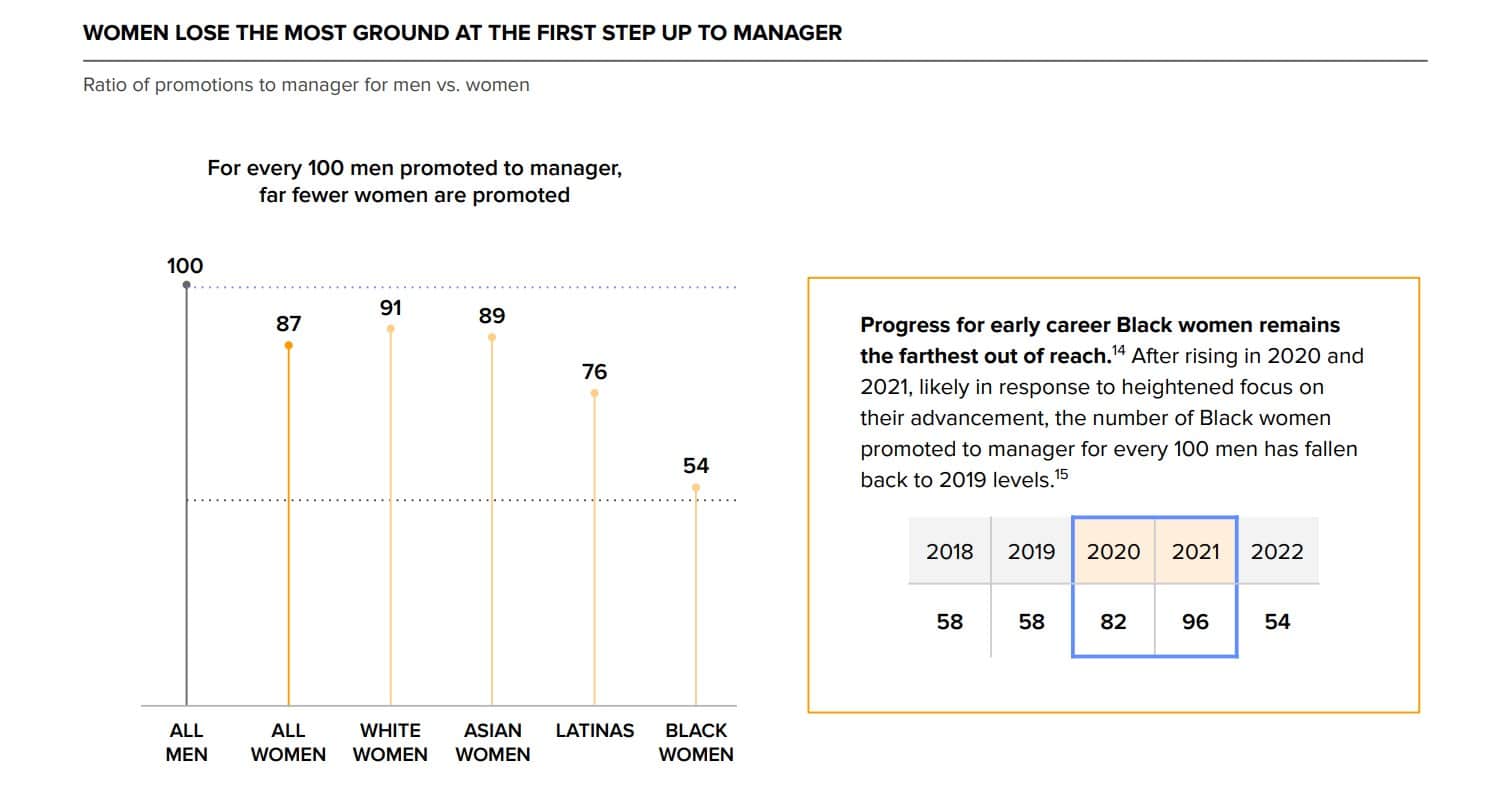
Myth #3: Microaggressions have a “micro” impact.
Reality: Microaggressions have a large and lasting impact on women.
Years of data show that women experience microaggressions at a significantly higher rate than men, making the workplace a mental minefield for many women. Nearly half of women experience microaggressions at work that call their competence and abilities into question:
- Women are twice as likely as men to be interrupted and hear comments on their emotional state.
- Women are 1.5x more likely than men to have a colleague take credit for their work.
And for women with traditionally marginalized identities, these slights happen more often and are even more demeaning:
- For example, Asian and Black women are over 3x more likely than women overall to be confused with someone of the same race and ethnicity.
- Most women (78 percent) who face microaggressions self-shield at work, adjusting the way they look or act in an effort to protect themselves.
- Women who experience microaggressions and self-shield are more than ~3x more likely to think about quitting their jobs and struggle with burnout than those who don’t.
Nearly a third of women don’t speak up or share an opinion so they don’t seem difficult, compared to about a fifth of men overall. This is worse for women with marginalized identities:
- Almost 50 percent of women with disabilities
- About 40 percent of Black women and LGBTQ+ women
Women with marginalized identities often code-switch to blend in compared to men, who code-switch less than 10% of the time:
- Almost 40 percent of Black women
- Almost 30 percent of LGBTQ+ women and women with disabilities
One out of four women feel like they have to perform perfectly to avoid scrutiny or judgment compared to 15 percent of men overall:
- Over 40 percent of women with disabilities
- Over 30 percent of Black women and LGBTQ+ women
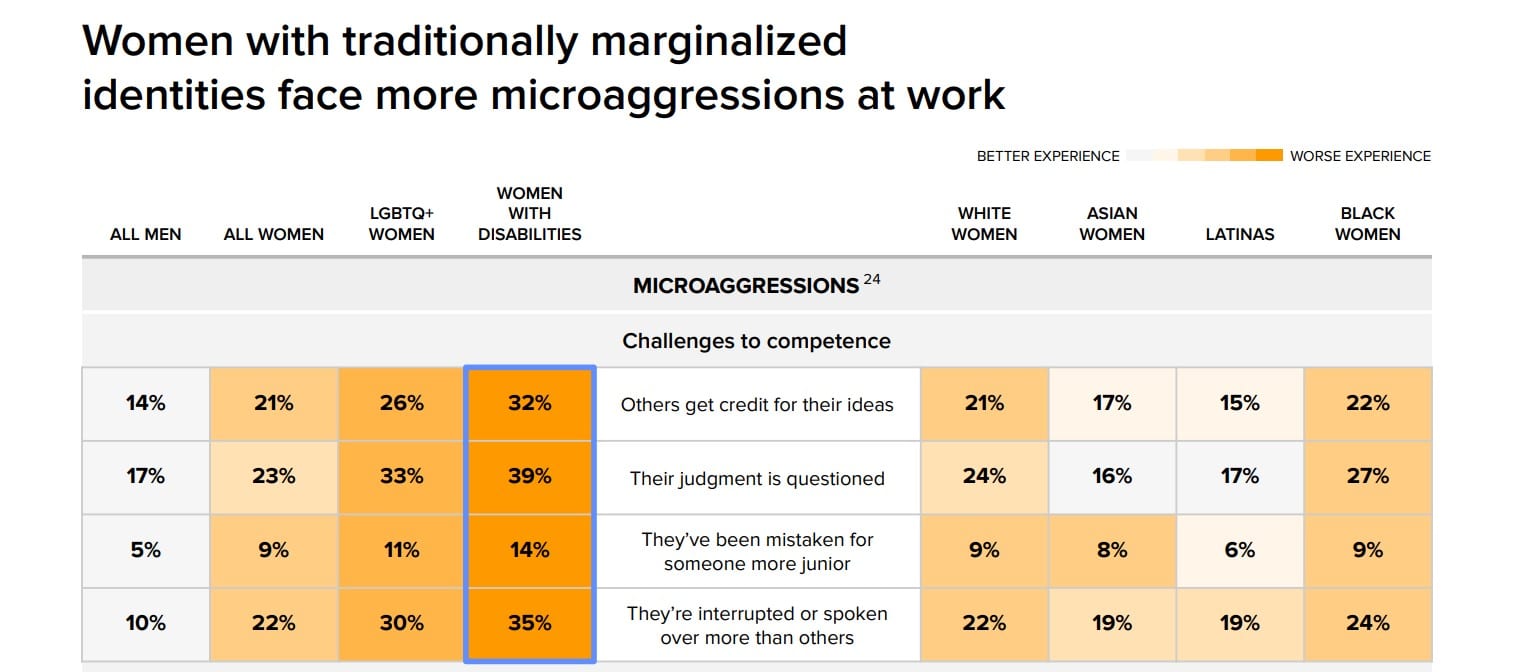
Myth #4: It’s mostly women who want—and benefit from—flexibility.
Reality: Men and women see flexibility as a “top 3” employee benefit and critical to their company’s success.
Employees place a high premium on flexibility and believe it is core to the future of work—ranking it even higher than employee benefits such as parental leave and childcare, with healthcare benefits ranked as most important:
- Half of women and a third of men point to “offering significant flexibility in when and where employees work” as a top factor in their company’s future success.
- Most notably, women are now far more likely to feel set up to succeed when they work remotely than two years ago: 32 percent this year vs.10 percent in 2021.
Remote and hybrid work deliver important benefits for women and men:
- More than 80 percent of remote workers—men and women—and about 70 percent of hybrid workers feel more efficient and productive.
- Women and men agree that remote and hybrid work make balancing work/life easier (over 80 percent of women and 79 percent of men).
- Over half of men and women working remotely or hybrid say they experience less burnout and fatigue.
- Half of women and a third of men feel less pressure to manage personal style of appearance when working remotely; similar for hybrid workers.
- Mothers place a particularly high premium on flexibility. Without flexibility, 57 percent of mothers with young children say they would have to leave their company or reduce their work hours.
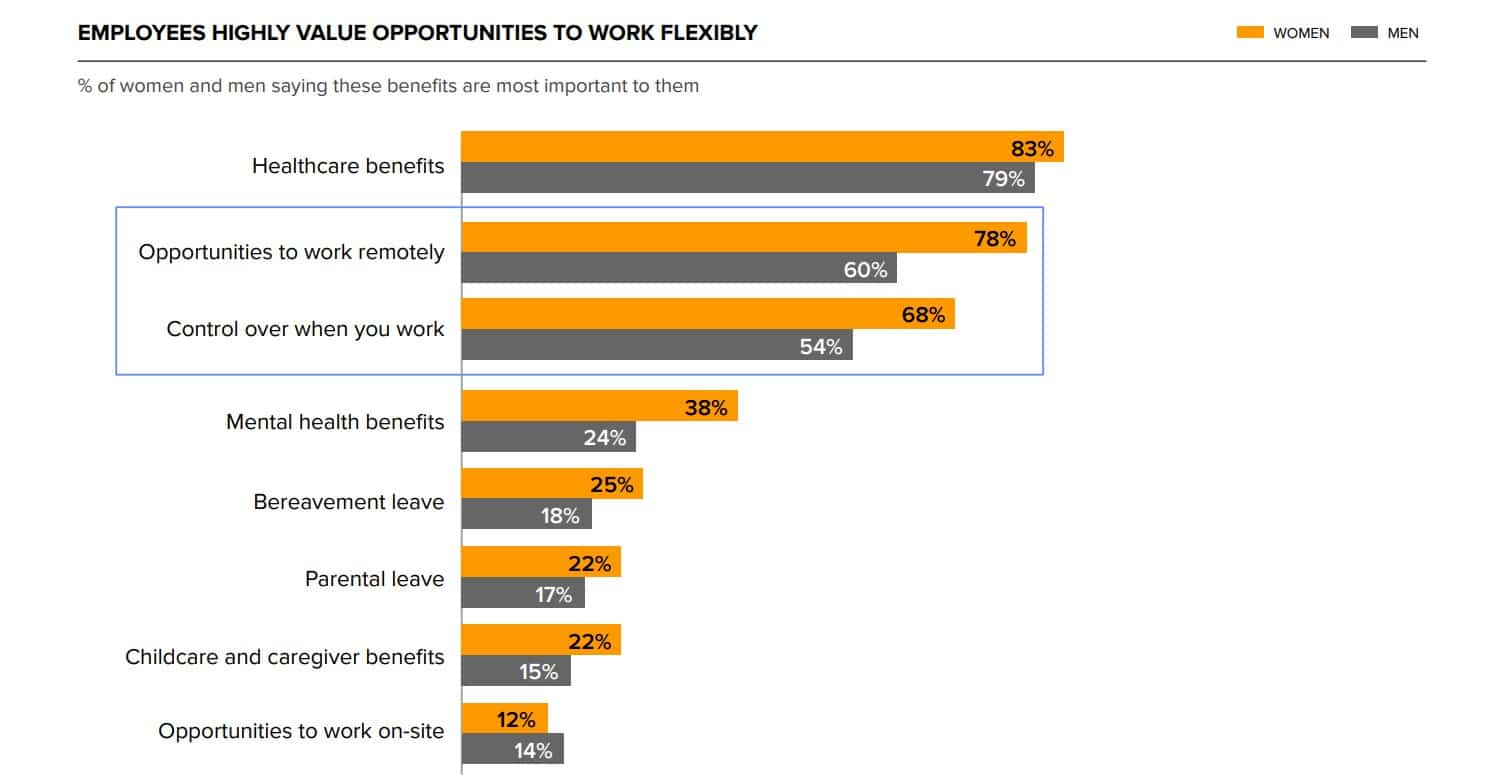
On-site work also delivers benefits. Approximately two-thirds of employees who work on-site point to an easier time collaborating and a stronger personal connection to coworkers as the biggest benefits of working on-site. However, it’s worth noting that:
- Men are benefiting disproportionately from on-site work: Compared to women, men report they are more “in the know,” more likely to receive the mentorship and sponsorship they need, and feel connected to their organization’s mission and their work.
- The culture of on-site work appears to be falling short: While 77 percent of companies believe a strong organizational culture is a key benefit of on-site work, only 37 percent of employees say this.
Download the full report here.
The Women in the Workplace study is conducted in partnership by LeanIn.Org and McKinsey & Company. The first study was released in 2015, and each year it examines current issues facing women in corporate America. This year’s report is based on data and insights from over 270 companies representing more than 10 million people, along with survey responses from over 27,000 individual employees.

